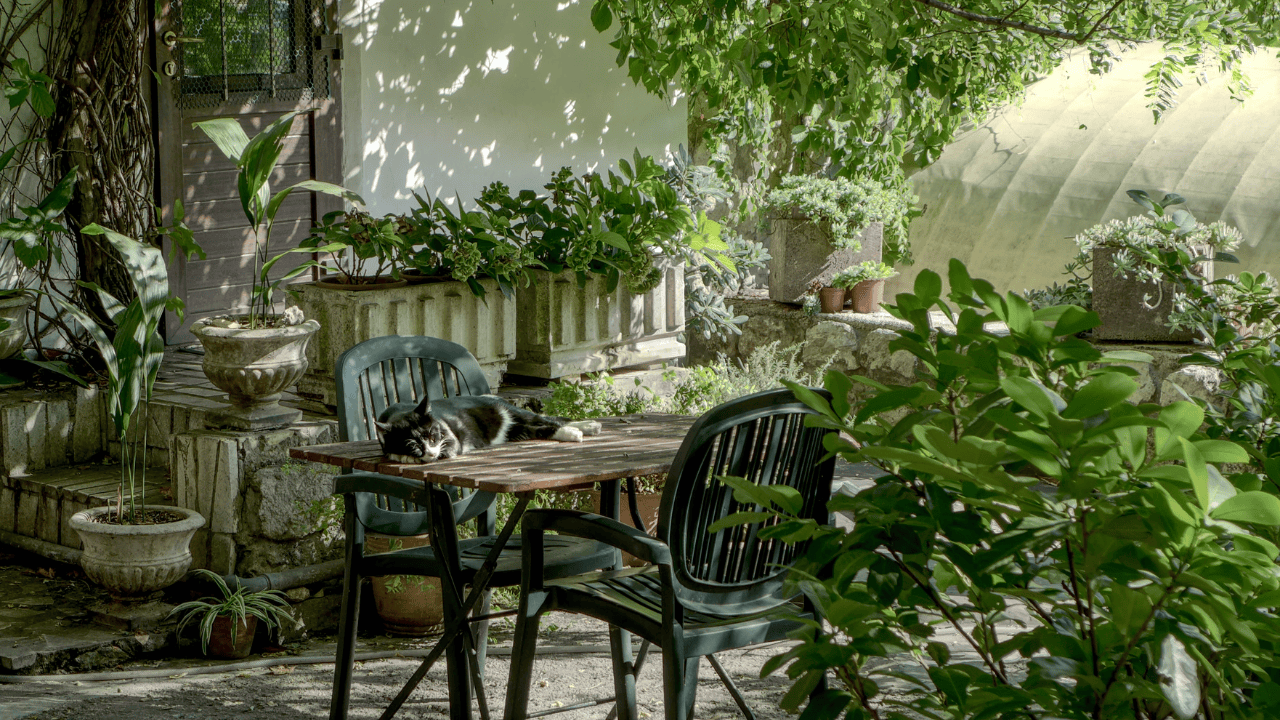It’s no secret that homeowners often dread yard work. Just thinking about everything that it entails is overwhelming to many. However, maintaining a clean, weed-free, spotless outdoor space doesn’t have to be as tricky as it is often perceived. You can still have a beautiful, nature-friendly backyard without investing too much time and effort.
Applying eco-conscious methods and incorporating clever, practical solutions into your landscape design can help protect the ecosystem, reduce your carbon footprint, and turn your backyard into a low-maintenance, pleasant space perfect for relaxing.
Here are some steps to help get you started.
At a Glance:
Here's a six-step procedure for creating a low-maintenance and eco-friendly backyard in Australia:
- Step 1: Plant low-maintenance perennials and pollinator gardens
- Step 2: Plant trees for natural air-conditioning
- Step 3: Consider using compost as a free, natural way of fertilising your garden
- Step 4: Make sure to keep your lawn in tip-top shape
- Step 5: Collect rainwater and install smart irrigation systems
- Step 6: Avoid toxic pesticides and use good bugs to eliminate pests naturally
Now, let's delve into these steps to provide detailed instructions and valuable insights while pointing out potential mistakes to steer clear of along the way.
Step 1: Plant low-maintenance perennials and pollinator gardens

Other than being a powerful landscaping tool, plants also play an essential role in the preservation of pollination species. Plants that produce nectar and pollen attract wildlife to your garden, and other than making it beautiful, they are vital elements in the food and flower cycle.
Enriching your garden with plants that bloom earlier or later than the majority of plants will ensure insects and animals have something to pollinate during those cooler months when their options are scarce. Go for plants that are native to your region because they’re already adapted to that certain climate, rainfall amounts, and the condition of the soil, which means they are relatively easy to care for.
Some of the low-maintenance, pollinator-friendly perennials you should incorporate are milkweed, waxflowers, coreopsis, and wild bergamot.
Step 2: Plant trees for natural air-conditioning

One of the most eco-friendly ways to spruce up your backyard and improve your home’s curb appeal, planting trees has many benefits for your home and your community. When the levels of A/C energy use escalate during warm summer days, our monthly utilities grow, and so does our carbon footprint. One way to cut air conditioning costs and be more environmentally conscious is to plant multiple trees in your backyard and strategically position them.
Just like they act as natural air-conditioning units during summer, trees can also reduce the cooling effects of cold winters. Deciduous trees planted on the west and south sides of your home will provide shade during summer, but they’ll also shed their leafy coats once the temperatures plummet, allowing the sun’s rays to pass through and warm up your home. By planting trees, you’ll also provide a home for local wildlife, such as birds, insects, and small mammals, which is another way to preserve Mother Nature and her creations.
Explore our collection of fast-growing Australian native trees that can quickly transform your landscape, whether you're looking for shade, privacy, or aesthetic appeal.
Step 3: Consider using compost as a free, natural way of fertilising your garden

Wondering what to do with your kitchen leftovers? Instead of tossing them in the bin like most people do, you can put your food scraps and leftovers to good use. Besides reducing the waste you create, composting is a great way to fertilise your garden – and for free!
It gives you a chance to nourish your soil naturally, thus eliminating the need for chemicals that pollute the environment. To start composting, choose a designated area of your backyard and install a compost bin, which you will use to dispose of food waste such as eggshells, scraps from fruits and vegetables, weeds, and coffee grounds. After a while, the organic waste will decompose, creating a nutrient-rich soil.
Step 4: Make sure to keep your lawn in tip-top shape

To make your lawn appear healthier, let the grass grow a couple of inches before you mow it. The roots will go deeper, helping your lawn to cope better with the drought during warm months. Mowing high will also make your lawn thicker, resulting in fewer garden pests and weeds, thus reducing the need for chemical treatments.
For gardening tools, your lawnmower is one of the more expensive items you’ll invest in, so you must ensure it’s in working condition. Usually, all the mower needs is changing spark plugs or oil. However, sometimes, there might be some mechanical issues that require repairs.
Of course, suppose you have some severe acreage to mow and keep breaking your mower and your back, too, then you may decide to purchase a ride-on mower. In that case, some models, such as John Deer, are of such good quality. Then again, these quality machines cost a fair bit, and you may be better off hiring a professional lawn mowing service.
If you're looking to maintain a lush and healthy lawn, it's essential to start with the right equipment. Learn how proper lawnmower care plays a crucial role in achieving your green oasis.
Step 5: Collect rainwater and install smart irrigation systems
Water preservation is another step toward a more sustainable future, and it’s one of the easiest ways to maintain your landscape. The rainwater you collect can water the plants, the lawn, and vegetable gardens without outdoor household water. It's perfect for reducing your monthly water bills.
Rainwater harvesting is done with the help of rain barrels or cisterns, and it’s a big step in reducing your water footprint. Installing smart irrigation systems is a more high-tech fix that will help decrease your water use.
By using smart controllers to remotely monitor and adjust irrigation so that it suits the weather and soil conditions, you can create an automatic watering schedule that will fit the needs of your lawn and garden.
Step 6: Avoid toxic pesticides and use good bugs to eliminate pests naturally

Not only are pesticides harmful to our health, but they are also detrimental to the environment. Even though they effectively kill pests, pesticides also rid your garden of good bugs, not to mention how the harmful chemicals they’re packed with end up in our water systems and pollute precious natural resources.
Forgo the toxic chemicals and let nature take care of pests. Mites, scale insects, and aphids can easily become a meal for our cute and helpful friends – ladybugs. At the same time, cabbageworm, caterpillar, and beetle infestations can easily be fixed with the help of parasitic wasps.
Frequently Asked Questions (FAQs)
Here are some frequently asked questions on creating a low-maintenance and eco-friendly backyard.
What is the most efficient way to remove grass?
There are several efficient ways to remove grass:
- Dig-it-up Method: This involves cutting the grass into 1-foot-wide strips using a flat spade or an edger, then digging under the strip with a shovel to remove the sod layer. It's a bit labour-intensive but effective.
- Sheet Mulching: This is an eco-friendly method that involves covering the grass with a layer of cardboard or newspaper and then adding compost and mulch on top.
- Using a Tiller: A tiller—a gas-powered machine that uses blades to break up the soil and roots of anything in its way—is an efficient tool for removing grass.
Consider your specific needs, including how much time, money, and effort you're willing to invest in the process when choosing an approach.
What is the easiest grass to manage?
The easiest grass to manage in Australia varies depending on the specific conditions of your garden and your own tendencies as a gardener. Here are some popular choices:
- Soft Leaf Buffalo Grass: This grass is relatively low-maintenance and self-repairs rapidly, meaning fewer patches and dead spots. It also has excellent resistance to pests and diseases.
- Zoysia Grass: Known for its ability to withstand heat, cold, droughts, and high levels of foot traffic, Zoysia grass requires less mowing than other varieties and has low fertiliser requirements.
- Couch Grass: This is an easy-going and cheaper grass that can make for a great-looking lawn when treated correctly. It holds up against wear and tear and is capable of repairing itself rather quickly due to its vigorous underground runners.
- Sir Walter Buffalo Turf: An extremely resilient, low-maintenance lawn that thrives in shade and heat without much water.
- Weeping Rice-Grass: In South Australia, weeping rice-grass makes a great lawn. It can be grown throughout the state but fares best in cool, semi-shady spots.
How do you make an eco-friendly path?
There are several ways to create an eco-friendly path:
- Specify Low Carbon Paving: There is a push to make pavers using less carbon. It’s kinder to the environment and helps protect your carbon footprint.
- Use Permeable Paving: This type of paving allows water to drain through, reducing runoff and recharging groundwater.
- Reclaim or Upcycle: Reusing materials can reduce the environmental impact of your path.
- Incorporate Planting: Adding plants to your path can increase its eco-friendliness.
- Lay a Ribbon Driveway: This involves two parallel tracks with a strip of grass in the middle.
- Choose Open Concrete Grids: These allow grass or other plants to grow through, reducing the amount of impermeable surface.
- Choose Sustainable Natural Stone Paving: Natural stone is durable and can be sourced sustainably.
- Small Stones and Sand: These materials allow for water drainage and are also inexpensive and quick to install.

Cheers to a Sustainable Future
Creating a low-maintenance and eco-friendly backyard is achievable and incredibly rewarding. By implementing the six steps outlined in this blog, you can reduce your environmental footprint, conserve resources, and enjoy a beautiful outdoor space that requires minimal upkeep.
From native plants and efficient irrigation to sustainable materials and mindful design, your backyard can become a haven for you and the planet. Embrace these eco-friendly practices, and watch as your outdoor sanctuary thrives while positively impacting the environment. Here's to a greener, more sustainable future, one backyard at a time.








